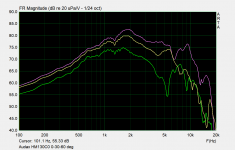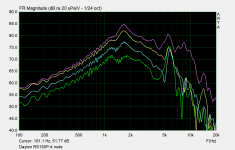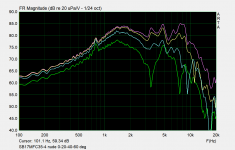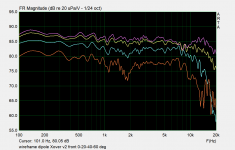Correct. If the drivers are in a planar (not folded) baffle the analysis should be the same. The baffle increases the front-to-back pathlength just as with a single driver.Can I just confirm I’ve understood what you are envisaging here; you are talking about the clamshell configuration but with the difference that the 2 drivers are each mounted on a baffle. Yes?
Juhazi is on point here. What you want are the lines to be parallel, like in the green area of the lower plot. When the lines cross, you are getting nulls or beaming, and this is undesirable. The b=2a case is about the upper limit to the baffle dimension. As baffle size increases the "****" just gets worse, and with diminishing baffle size it goes away.Now you guys are getting at the heart of multiway-fullrange-dipole system!
http://www.dipolplus.de/thema4.html ( I painted over Finke's pic)
View attachment 1011352
I suggest you investigate what happens as the ratio of driver diameter to baffle diameter is changed. You are presenting a "worst case" where the baffle diameter (b) is much larger than the diameter of the radiating surface (a). What happens as b decreases so that it becomes only just larger than a?Sound waves cancel each other even if the wavelenght is shorter than baffle
Actually we both right as both things happen at same frequencies so it can be said that diffraction for OB manifest itself as -6dB slope below first dipole peak and series of peaks and dips above it. The difference between box speakers and OB is in that the box speakers have baffle step and OB has full cancellation below first peak. Above first peak there is diffraction ripples for boxes and much stronger peaks/dips for OB.
Below are edge simulations for baffle step and OB of same dimensions so difference is easy noticeable. There is picture from Finke paper as well form
View attachment 1011305View attachment 1011306View attachment 1011308
so with smaller or without baffle all that ripples just moving up in frequency.
Something is little bit strange with yours measurements as circular baffle has most pronounced peaks /dips due to equal distance and your measurement show opposite
I exaggerated the simulation for better visualization of OB effect. I do not think that anybody will put 100mm driver on 620 mm baffle.
Happens same thing but less pronounced.
Anyway drivers in OB system should be crossed over below its own first peak if we want to utilize all positive aspects of OB system like constant directivity and 4-5 dB higher sound intensity on axis. Both things are lost above first peak. Because of that Linkwitz and Kreskovsky used separate baffle for each driver.
So far it is impossible to do it with tweeter due to size, but as well there is no point to use the woofers without any baffle if we are going to cross it enough low
Happens same thing but less pronounced.
Anyway drivers in OB system should be crossed over below its own first peak if we want to utilize all positive aspects of OB system like constant directivity and 4-5 dB higher sound intensity on axis. Both things are lost above first peak. Because of that Linkwitz and Kreskovsky used separate baffle for each driver.
So far it is impossible to do it with tweeter due to size, but as well there is no point to use the woofers without any baffle if we are going to cross it enough low
My apologies that should have read "noise floor of the environment" not microphone.Just thought I'd pick up on this.
A good small-diaphragm condenser mic (Beyerdynamic MC930) has a maximum SPL before clipping of 140dB, and a self-noise of 16dB.
ie, 126dB of dynamic range.
That's far in excess of anything I can reproduce at home: my ambient noise level is in the 40-50dB range, so I'd need to be able to put out at least 166dB (at my listening position) to make maximum use of that particular microphone. My speakers won't do that, and if they did, I wouldn't want them to.
Having performed acoustic measurements below my hearing threshold, I can say, with some certainty, that the microphones aren't at fault here.
Chris
@bushmeister : can I ask where you sourced the stand-offs you use between the woofers. The ones I’ve seen are pretty pricey.
I have been looking through my emails. I can't seem to find the receipt, bear with me, and I will look for the paperwork!
I'm developing systems (as in working on several of them at roughly the same time) in which no driver in mounted in a baffle at all - all drivers are 100% nude. This has different consequences for the midrange and the woofer, the latter which i only take down to 100Hz to 150Hz. For me, the midrange absolutely must be 100% nude because it must be used both above and below its dipole peak. It turns out that this actually works out pretty nicely, but you need the right driver and it must be the right size. The right size is the 6"-7" class, with rare exceptions down to 5.5", for example a Dayton RS150 size works well like this. 95% of drivers that I have tested in this size class also have a resonance peak located near the dipole peak. SL thought this was due to the space behind the cone inside the basket. I'm not sure sure about that. Essentially the same driver frame and motor but with different cone material has a wide variety of this peak, in terms of shape and extent, some without the peak at all. So it might be the dust cap, surround, or the cone itself. I don't really care. I try to carefully measure the drivers outdoors to get high resolution data with which I can clearly see everything, but in a pinch some careful indoor measurements can see this as well. Luckily I have found some drivers that behave well and have relatively low distortion when used nude as a midrange. I mate these with a dipole tweeter. There are not too many that will work well, but these hardly need any EQ at all when crossed over properly. The woofer has the most demand put on it since the passband is completely below the dipole peak. But as long as you only use this driver down to 150Hz you can use a nude 10" or 12" driver and it works fine. Below that I am using a closed box subwoofer. This is the new paradigm that I am developing speakers under. So far I have at least four interesting projects coming along or finished, and to me they sound very nice. They are all virtually constant directivity above 150Hz due to the use of nude drivers.Anyway drivers in OB system should be crossed over below its own first peak if we want to utilize all positive aspects of OB system like constant directivity and 4-5 dB higher sound intensity on axis. Both things are lost above first peak. Because of that Linkwitz and Kreskovsky used separate baffle for each driver.
So far it is impossible to do it with tweeter due to size, but as well there is no point to use the woofers without any baffle if we are going to cross it enough low
Finally, do not believe TheEdge simulations to closely. The program does not accurately predict the response shape and
SPL level, at least for the nude drivers I am working with. Probably other cases as well. The responses are a good guide to the SHAPE of the response more or less, but accuracy is not all that great in terms of frequency and gain/loss.
Edge is quite simple and useful for visualize general behavior but is far, far away than real simulation.
About different ways of using the drivers I already said how they should be used and way. Of course, one can use them as one want but that does not mean that is the best way.
It seems that your goal is to use nude drivers and you are willing to compromise all other aspects to achieve that goal and that is OK.
For nude drivers or minimal baffle dipole peak and start of beaming happens at same or very close frequency so as drivers beaming overtaking we get similar response to dipole bellow dipole peak. I think JohnK mentioned and called "quasi dipole". Probably some kind of minimal acoustically irregular (read square) will be better as it will spread the peak. It is doable but one more smaller driver will be better.
I would use dipole woofer from no more than 70-80 Hz. The difference is substantial, but again is very room dependable area.
About different ways of using the drivers I already said how they should be used and way. Of course, one can use them as one want but that does not mean that is the best way.
It seems that your goal is to use nude drivers and you are willing to compromise all other aspects to achieve that goal and that is OK.
For nude drivers or minimal baffle dipole peak and start of beaming happens at same or very close frequency so as drivers beaming overtaking we get similar response to dipole bellow dipole peak. I think JohnK mentioned and called "quasi dipole". Probably some kind of minimal acoustically irregular (read square) will be better as it will spread the peak. It is doable but one more smaller driver will be better.
I would use dipole woofer from no more than 70-80 Hz. The difference is substantial, but again is very room dependable area.
Yes, Edge is just a tool to get the general idea of dispersion and edge diffraction effects. But super in that!
When combining monopole woofer with dipole (low)mid, in transition range we get cardioid response pattern. This I believe was introduced by Jorma Salmi with his Gradient 1.n speakers in 1989. I dated a lady who had 1.3 about ten years later and fell in love with those Gradients! I didn't make a team with the lady, but I had to get or make the speakers... I studied the dipole challenges mainly from Linkwitz pages. later also from Kreskovsky and Finke too, and the minidsp thing came from John Reekie.
Multichannel DSP opened the sky for me, I started AINOgradient project in 2013. I started with LR4 slopes, but LR2 made transition between S and W softer. Biggest problem with that has always been measurement technique, because of the weather and complexity of the system, it has been very difficult to perform outdoor measurements.
https://gradient.fi/index.php?id_cms=9&controller=cms&id_lang=1

When combining monopole woofer with dipole (low)mid, in transition range we get cardioid response pattern. This I believe was introduced by Jorma Salmi with his Gradient 1.n speakers in 1989. I dated a lady who had 1.3 about ten years later and fell in love with those Gradients! I didn't make a team with the lady, but I had to get or make the speakers... I studied the dipole challenges mainly from Linkwitz pages. later also from Kreskovsky and Finke too, and the minidsp thing came from John Reekie.
Multichannel DSP opened the sky for me, I started AINOgradient project in 2013. I started with LR4 slopes, but LR2 made transition between S and W softer. Biggest problem with that has always been measurement technique, because of the weather and complexity of the system, it has been very difficult to perform outdoor measurements.
https://gradient.fi/index.php?id_cms=9&controller=cms&id_lang=1
Like I mentioned, you need to find the "right" driver to use it through (and especially above) the dipole peak. For some drivers there is increasing directivity starting at the dipole peak, and this is certainly a limitation. I have attached some quick (indoor) measurements on and off axis for drivers that stay together nicely above the dipole peak until you reach breakup. These are around the 6" diameter that I mentioned, which keeps the dipole peak at around 1.5kHz or so. These are very usable nude with some EQ to smooth and flatten the response. I had to measure many much worse drivers to find these gems.For nude drivers or minimal baffle dipole peak and start of beaming happens at same or very close frequency so as drivers beaming overtaking we get similar response to dipole bellow dipole peak.
Attachments
Nice findings Charlie, those behave like CD horn almost till cone break up.
With that response story is quite different. Have you got, maybe, sonograms?
With that response story is quite different. Have you got, maybe, sonograms?
Not for these drivers. I have some high resolution (e.g. 50Hz or better)measurements on other drivers that I made outdoors at the end of last summer. I will not be able to do any more high resolution measurements (to create a sonogram) on drivers or systems until late Spring. I only measured these drivers (from my last post) recently at 0.5m indoors. This limits me to measuring one driver by itself (that is what I showed above) or the midrange and tweeter together, at most. I can measure at e.g. 2m indoors but then there is a lot of eyeballing and guesswork involved, and the data is not pretty enough to show publicly.Nice findings Charlie, those behave like CD horn almost till cone break up.
With that response story is quite different. Have you got, maybe, sonograms?
I did manage to get one system going and measured outside before the winter, but the crossover was still preliminary at the time. The midrange was not a smooth as the drivers I showed above, so this system was eventually dismantled. Anyway, I am attaching that data below as an example of the directivity. Not a sonogram (I don't like them all that much) but line plots at a few angles (0-20-40-60 degrees) at least for front and rear.
Attachments
Reactivating this very interesting thread; I want to try this clamshell arrangement using 4 x BMS 18n862 that I own and use them up to c.200hz. Based on the findings reported in this thread I think this should work but I would welcome comments from the main contributors to this discussion.
True...clamshell is inefficient. Thats why I use 4 woofers and 2 amps to drive them. If you want deep bass you need to chose drivers that have a low FS, large Xmax & hi-ish QTS. UM18's work real well.
The advantages are:
*Less incitement of room modes
*No cabinet resonances (or cabinet construction) to worry about
*Compact design
*Quality of bass without cabinet colouration
You will hear bass for the first time from drivers that are not restricted or coloured by a cabinet.
PS just looked at the specs for the BMS. Fabric surround and low QTS (although high efficiency) not the best for this application unless you are not concerned with deep bass. If you are, and with a price of £600 you are better looking at the UM18's. Sound Imports will sell you 4 + Import duty for similar price.
The advantages are:
*Less incitement of room modes
*No cabinet resonances (or cabinet construction) to worry about
*Compact design
*Quality of bass without cabinet colouration
You will hear bass for the first time from drivers that are not restricted or coloured by a cabinet.
PS just looked at the specs for the BMS. Fabric surround and low QTS (although high efficiency) not the best for this application unless you are not concerned with deep bass. If you are, and with a price of £600 you are better looking at the UM18's. Sound Imports will sell you 4 + Import duty for similar price.
Last edited:
True...clamshell is inefficient.
The advantages are:
*Less incitement of room modes
*No cabinet resonances (or cabinet construction) to worry about
*Compact design
*Quality of bass without cabinet colouration
You will hear bass for the first time from drivers that are not restricted or coloured by a cabinet.
Facts.
"Force-canceling subwoofers work in pairs to cancel out vibrations for clearer bass tones.
They reduce vibrations in enclosures, allowing for more flexibility in speaker placement.
Worth the price for space-constrained devices or high-end home theater setups seeking premium audio quality."
https://www.howtogeek.com/what-are-force-cancelling-subwoofers-and-are-they-worth-it/
Yah....these 'naked. clamshells work totally different. The cones are acoustically in phase, so the opposing woofer is wired out of phase.....if not there would be total cancellation. The thing with this arrangement is the quality, not quantity of bass in a domestic environment subject to room anomalies.
- Home
- Loudspeakers
- Multi-Way
- The 'Circles of Doom’... Open baffleless full range speakers




